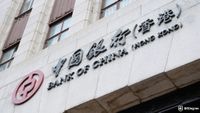Stablecoin issuers must meet a long list of requirements to receive a "MAS-regulated" label.
With a vision to infuse stability in the burgeoning stablecoin market, Singapore's central bank has unveiled its revamped regulatory guidelines for single-currency stablecoins.
According to the Monetary Authority of Singapore's announcement shared on August 15th, the new regulation targets non-bank stablecoins linked to prominent currencies, including the Singapore dollar, euro, British pound, and the US dollar.

Did you know?
Want to get smarter & wealthier with crypto?
Subscribe - We publish new crypto explainer videos every week!
What is a Rug Pull in Crypto? (Meaning + Examples)


It is worth noting that the framework becomes relevant for stablecoins that circulate beyond the threshold of 5 million Singapore dollars (equivalent to $3.7 million).
Deputy Managing Director of Financial Supervision at MAS, Ho Hern Shin, elucidated the goals of these new guidelines. Shin remarked:
<The objective is to recognize stablecoins> as a credible digital medium of exchange and as a bridge between the fiat and digital asset ecosystems.
Shin further urged stablecoin issuers to gear up for aligning with these guidelines if they wish to earn the title of being MAS-regulated.
Outlined within this robust framework are a multitude of requirements. Issuers of stablecoins are expected to uphold standards relating to redemption timelines, transparent disclosures, the prudent management of reserves, and adhering to defined capital prerequisites.
Stablecoin issuers must recognize that the “MAS-regulated” label will be reserved for those that strictly comply with this updated framework. According to MAS, the distinction will empower users to differentiate between regulated and non-regulated stablecoins.
On top of that, the bank is not shielding away from imposing stringent punitive measures. Any misrepresentation of a token as MAS-regulated could lead to consequences, including fines, incarceration, and being flagged on an alert list.
Singapore's central bank's proactive move signifies a concerted effort to fortify the stablecoin landscape, ensuring these digital assets are both credible and reliable. As the line between digital and traditional currencies continues to blur, such meticulous regulation will undoubtedly bolster confidence among both issuers and users.






















